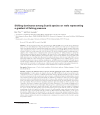The present paper analyzes data collected between 2001 and 2002 on 81 reef fish species targeted by fishers at 5 sites in the Kingdom of Tonga (South Pacific). We first ranked the sites with respect to fishing pressure using two independent methods: (i) Tongan demography and reef surfaces available for fishing, and (ii) the differential effects of fishing on the whole set of 81 species grouped by their life history traits (LHT). We then focused on Parrotfish (Scaridae), which are heavily targeted in coral reef fisheries. We used the identified gradient of fishing pressure to study the effect of fishing on the community structure and test the hypothesis of « shifting dominance » amongst the 20 Scarid species present in the surveys. In addition to the classical effect of decreasing fish size in a family strongly targeted by fishers, the shifting dominance phenomenon includes a decrease in the abundance of the large-bodied and highly targeted species, favouring their replacement by smaller-bodied species from the same family, which are less impacted by fishing. In a context of interspecific competition amongst Scarids, the stress of fishing appears as a factor favouring the replacement of species with large maximum size, and LHT promoting low resilience, by smaller species with the opposite attributes. The discussion focuses on the various processes that can explain the shifting dominance phenomenon. The total density of resilient species, which increased along the gradient of increasing fishing pressure, can be used as an indicator of the over-exploitation of fish communities for reef fisheries management.
Liste




 English
English